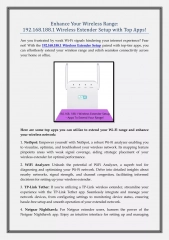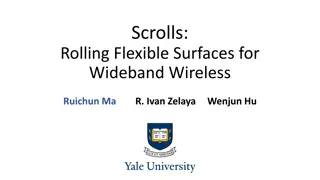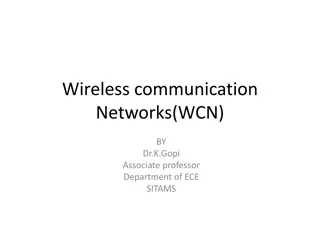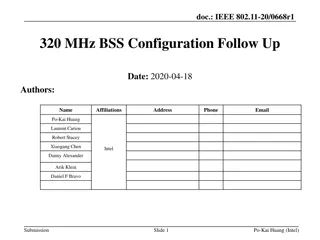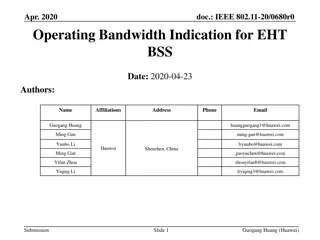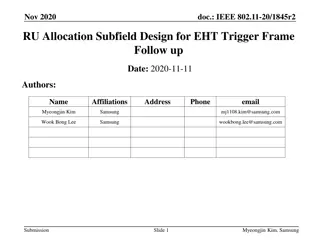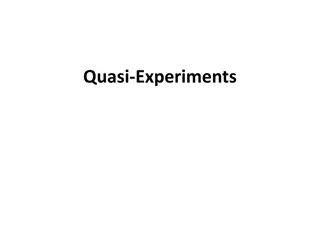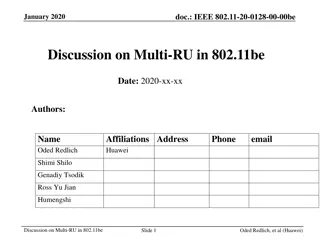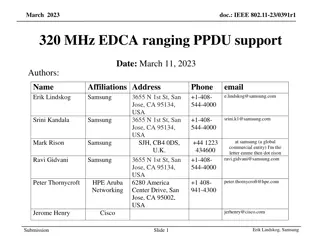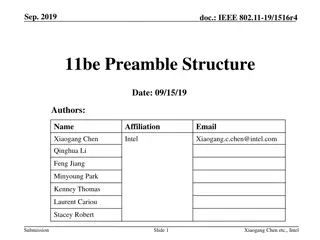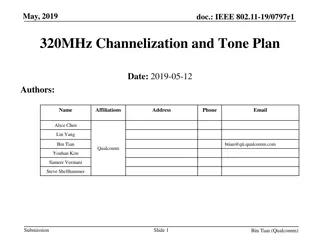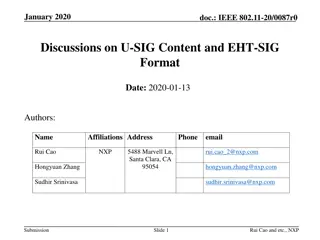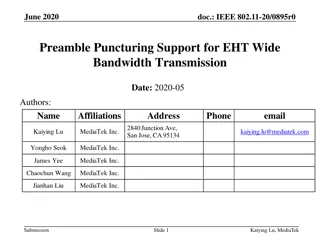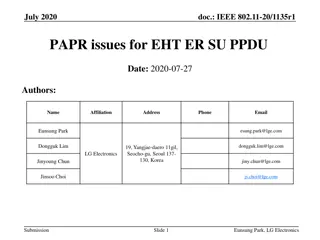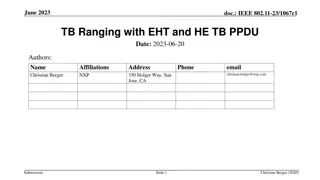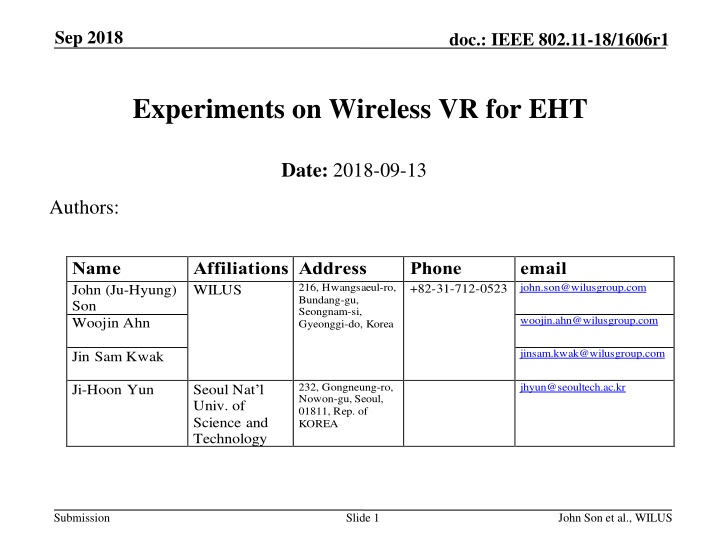
Experiments on Wireless VR for Extremely High Throughput: Analysis and Findings
Explore the impact of wireless VR technology on EHT networks, focusing on latency evaluation and network requirements for VR streaming. The study delves into VR content streaming under various configurations, including compression effects on data rate requirements.
Download Presentation

Please find below an Image/Link to download the presentation.
The content on the website is provided AS IS for your information and personal use only. It may not be sold, licensed, or shared on other websites without obtaining consent from the author. If you encounter any issues during the download, it is possible that the publisher has removed the file from their server.
You are allowed to download the files provided on this website for personal or commercial use, subject to the condition that they are used lawfully. All files are the property of their respective owners.
The content on the website is provided AS IS for your information and personal use only. It may not be sold, licensed, or shared on other websites without obtaining consent from the author.
E N D
Presentation Transcript
Sep 2018 doc.: IEEE 802.11-18/1606r1 Experiments on Wireless VR for EHT Date: 2018-09-13 Authors: Name John (Ju-Hyung) Son Woojin Ahn Affiliations Address WILUS Phone +82-31-712-0523 john.son@wilusgroup.com email 216, Hwangsaeul-ro, Bundang-gu, Seongnam-si, Gyeonggi-do, Korea woojin.ahn@wilusgroup.com jinsam.kwak@wilusgroup.com Jin Sam Kwak 232, Gongneung-ro, Nowon-gu, Seoul, 01811, Rep. of KOREA jhyun@seoultech.ac.kr Ji-Hoon Yun Seoul Nat l Univ. of Science and Technology Submission Slide 1 John Son et al., WILUS
Sep 2018 doc.: IEEE 802.11-18/1606r1 Introduction In July meeting, the motion for EHT SG formation was passed as follows: [1] Approve formation of the 802.11 Extremely High Throughput (EHT) Study Group to consider development of a Project Authorization Request (PAR) and a Criteria for Standards Development (CSD) responses for a new 802.11 amendment for operating in the bands between 1 and 7.125 GHz, with the primary objectives: To increase peak throughput and improve efficiency To support high throughput and low latency applications such as video-over-WLAN, gaming, AR and VR The wireless VR was discussed as one of the main use cases for EHT [2][3][4] In order to support wireless VR transmissions in EHT, the network requirements of VR contents should be investigated. In this submission, we evaluate latency characteristics of VR contents streaming under various configurations. Submission Slide 2 John Son et al., WILUS
Sep 2018 doc.: IEEE 802.11-18/1606r1 Wireless VR system Host PC Audio/Video Capturer Audio/Video Encoder RTSP/RTP/ RTCP UDP Audio/Video Rendering HMD Sensor Data (uplink) Depacketizing motion data WLAN STA WLAN AP UDP RTSP/RTP/ RTCP Audio/Video Decoder Audio/Video Player Motion data Packetizing VR Contents (downlink) VR HMD Host PC Motion data Acquisition VR HMD VR requires a local (or cloud) host PC for real-time rendering of a virtual image based on the user s latest head direction measured from HMD internal sensors Wireless VR replaces HDMI and USB cables with wireless link which delivers the VR contents (downlink) and HMD sensor data (uplink) Without video compression, the data rate requirements for VR contents will be in the order of tens of Gbps [3] However, with video compression, we observed the data rate requirements reduce to the order of tens of Mbps which can be delivered in 11n or 11ac networks In this submission, we mainly investigate network latency characteristics when streaming compressed VR contents Submission Slide 3 John Son et al., WILUS
Sep 2018 doc.: IEEE 802.11-18/1606r1 Wireless VR streaming experiments setup VR Frame Rate: 30 or 60 FPS VR Resolution: 1280x800 or 1600x900 Video Capturing/Streaming Engine: GamingAnywhere [5] Video Codec: FFmpeg H.264 (AVC) (options: Ultrafast, IntraRefresh=ON/OFF) AP: ASUS RT-ac66 (11n, 11ac) STA: ASUS USB-AC56 Dual-band AC1300 (11n, 11ac) 11n BSS setting: 11n@2.4GHz (1STA Iperf avg: 25Mbps) 11ac BSS setting: 11ac@5GHz (1STA Iperf avg: 290Mbps) Submission Slide 4 John Son et al., WILUS
Sep 2018 doc.: IEEE 802.11-18/1606r1 Video encoding/decoding processing latencies Encoding processing latency Host PC: Intel i7 4.0GHz CPU, NVIDIA GTX 1080 GPU FFmpeg SW library or GPU acceleration (NVENC) Encoding latency was stable at around 2ms on both SW/HW settings Further applied IntraRefresh=ON option to avoid the video frame size variations Decoding processing latency Client PC: Intel i7 2.4GHz CPU, Intel HD Graphics 3000 GPU FFmpeg SW library only Decoding latency fluctuates according to video content variations With the decoding acceleration, we assume that the total encoding/decoding latency would be limited to under 10 msec in total Submission Slide 5 John Son et al., WILUS
Sep 2018 doc.: IEEE 802.11-18/1606r1 Frame size variation vs. Network latency (11n, 11ac) (1/2) 200 Frame size (Kbytes) 150 Encoded Video Frame Size 100 50 IntraRefresh =OFF 0 1 101 201 301 401 501 601 701 801 901 video frame index 120 Network latency (ms) 100 80 11n Network Latency 60 40 20 0 1 101 201 301 401 501 601 701 801 901 120 Network latency (ms) 100 80 11ac Network Latency 60 40 20 0 1 101 201 301 401 501 601 701 801 901 After video compression, we observed periodic big size keyframe (I-frame) which makes network latency increasing very much Important to regulate the frame sizes to have constant network latency Submission Slide 6 John Son et al., WILUS
Sep 2018 doc.: IEEE 802.11-18/1606r1 Frame size variation vs. Network latency (11n, 11ac) (2/2) 200 Frame size (Kbytes) 150 Encoded Video Frame Size 100 50 IntraRefresh =ON 0 1 101 201 301 401 501 601 701 801 901 video frame index 120 Network latency (ms) 100 80 60 11n Network Latency 40 20 0 1 101 201 301 401 501 601 701 801 901 120 Network latency (ms) 100 80 11ac Network Latency 60 40 20 0 1 101 201 301 401 501 601 701 801 901 Tried to regulate video frame sizes with IntraRefresh=ON (no I-frame) encoding option in which the keyframe is "spread" over many frames. Still observed 11n have latency spikes, while the large network bandwidth of 11ac makes the latency low Submission Slide 7 John Son et al., WILUS
Sep 2018 doc.: IEEE 802.11-18/1606r1 Multi-STA Contention vs. Network latency (11ac) Network latency (ms) video frame index Experimented one vs. two pairs of VR server-client sets in the same 11ac network 11n network had much steeper latency increase when there is contention Even the large bandwidth of 11ac suffers from the latency increase, mainly from the frame buffering at sender side from channel contention All the subsequent frames will suffer from the increased network latency as well, from the constantly generating video frames and the Head of Line Blocking effect Submission Slide 8 John Son et al., WILUS
Sep 2018 doc.: IEEE 802.11-18/1606r1 Uplink/Downlink Contention vs. Network latency (11n) Effects of Uplink Motion Data Contention on Downlink Network Latency 100 Wireless Motion Uplink Wired Motion Uplink 90 80 Network latency (ms) 70 60 50 40 30 20 10 0 1 101 201 301 401 501 601 701 801 901 1001 1101 1201 1301 1401 1501 video frame index VR requires very frequent (but small size) uplink data transmission to deliver the current user s motion data Measured the effects on the downlink video latency when there is also the uplink motion data transmission in the same network or not For comparison, we delivered the motion data through the same WLAN (Wireless) or Ethernet (Wired) Video downlink latency fluctuates very much from the uplink contention in the same network Submission Slide 9 John Son et al., WILUS
Sep 2018 doc.: IEEE 802.11-18/1606r1 Discussions High throughput would be beneficial for reducing the network latency spikes when transmitting large video frames However, for the multi-STA contentions and uplink/downlink contentions, we need additional methods to minimize the latency 11ax s OFDMA may be beneficial for multi-STA contentions 11ax s Cascading or TWT may be beneficial for uplink/downlink contentions Needs more study whether 11ax would provide enough means for reducing latencies under contention environments Recommend EHT SG to investigate further whether additional mechanisms are required to support latency critical applications such as wireless VR transmission Multi band operation for downlink/uplink separation [6] Scheduling for extremely frequent traffic flows Submission Slide 10 John Son et al., WILUS
Sep 2018 doc.: IEEE 802.11-18/1606r1 Conclusions We experimented compressed VR contents streaming Video compression would reduce the huge data rate requirements of VR contents which makes it feasible to stream those in WLAN networks However, we observed network latency fluctuations under different network settings Regular/Irregular video frame sizes Multi-STA contentions Uplink/downlink contentions Increasing the network throughput would be beneficial for the latency reduction of the transmission of high resolution video frames EHT SG should investigate additional methods to minimize latency fluctuations when there are contentions from multiple uplink/downlink flows Submission Slide 11 John Son et al., WILUS
Sep 2018 doc.: IEEE 802.11-18/1606r1 References [1] 11-18-1263-03-0eht-eht-subgroup-formation-motion [2] 11-18-0789-10-0wng-extreme-throughput-802-11 [3] 11-18-0846-02-0wng-next-generation-phy-mac-in-sub- 7ghz [4] 11-18-1160-00-0wng-controlling-latency-in-802-11 [5] http://www.gaminganywhere.org [6] 11-18-1518-00-0eht-eht-multi-channel-operation Submission Slide 12 John Son et al., WILUS

